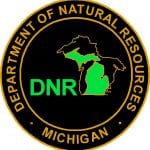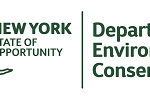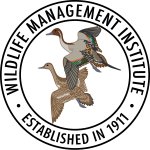Jump to:
Taking a close look in the mirror
The Agency Culture and Capacity Characterization (ACCC) and readiness diagnostic questions are designed to help an organization decide whether to proceed with the Agency Self-Assessment and workshop. The ACCC focuses on characteristics of the referent’s culture and capacity relating to readiness to address change; it takes the form of a set of word or phrase couplets that are used to characterize your organization.
The readiness diagnostic questions can be used by the team responsible for making the decision whether or not to proceed with the Agency Self-Assessment and workshop to analyze the results of the characterization exercise.
Four basic considerations
Four interwoven considerations need attention prior to making a decision to proceed with the Agency Self-Assessment and workshop.
- Referent (e.g., agency, division, work unit)- You need to be clear about the referent, which is the “unit” or “level” of the organization that is going to be the focus of attention.
- Leadership support– You need to have the support of your agency’s leader(s) at the appropriate level of the organization.
- Guiding coalition– Although the top-ranked leader may set the tone and direction (a compass), involvement by a coalition of other respected formal and informal leaders in the agency is usually a necessity to keep any initiative steady on its course (a gyroscope).
- Answer this question: Ready to go? You need to judge whether your agency is ready to engage in an assessment. Careful consideration of agency readiness to engage critically and productively in a self-assessment of its traits and practices relative to applying public trust thinking and good governance norms.
If your agency is not ready for this kind of analysis and discussion, adoption of actions that will result in improvement is an unrealistic expectation. At best, pushing forward in a largely unresponsive organization almost certainly would be frustrating; at worst, it could be counterproductive. But expecting everyone or even a majority to welcome an assessment of agency practices also is unrealistic, and unnecessary to initiate a change strategy. Even if only one division, section or program is ready to consider change, that entity’s movement may demonstrate the process and its benefits (i.e., benefits of alignment with Wildlife Governance Principles), leading to other units gaining confidence to follow suit. This points out the need to carefully consider what the referent should be for a readiness analysis—the entire agency, a major division, a section or a program. The readiness diagnosis should focus on the entity that will be evaluated for the self-assessment tool. The better the match, the more useful the readiness diagnosis as input to a judgment about whether or not to proceed.
Who should be involved in the readiness diagnostic?
- Large number of people unnecessary; 5-6 is about right
- Characteristics of participants on a readiness diagnostic team:
- capable of productive dialogue
- no hidden agendas
- willing to engage
- in a position to affect change and willing to convince, cajole or compel staff involvement in WGPs alignment assessment
- broad knowledge of organizational referent
- thoughtful and open to new ideas
- Don’t leave key people out
ACCC Instrument
The ACCC instrument focuses on characteristics of the referent’s culture and capacity relating to readiness to make needed changes. The ACCC takes the form of a set of word or phrase couplets that you can use to characterize your agency. Here is an example from the instrument.
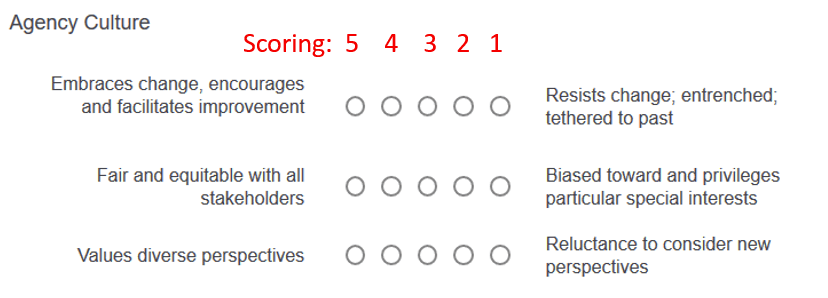
We designed the instrument to be taken independently by team members, with the option for the data to be compiled and reported in aggregate to the team or simply to be an individuals’ preparation for the full team discussion, which would include people sharing their ACCC results with one another.
To view the full ACCC instrument, click here.
If you are interested in taking an online version of this instrument and getting a free results report send an email to ptpractice@cornell.edu.
ACCC Results
The ACCC instrument is likely only to be completed by a few people in your agency, so it is important to remember that it does not provide statistically meaningful results. The output from the ACCC does provide a summary of the subjective perceptions of the individuals who complete the ACCC and is intended to be used in conjunction with the readiness diagnostic questions (see below).
The report from this exercise presents results in two straightforward, complementary ways; a set of dial diagrams and in tabular form. The dial diagrams display the mean values for the results for each organizational characteristic couplet. The dial diagrams use a three-color scheme where red is displayed for means of 1.5 or less, yellow is for means between 1.5 and 3.5, and green is used for means higher than 3.5. This representation of the data allows you to quickly identify those characteristics that participants rated toward the positive, negative or middle of the scale.
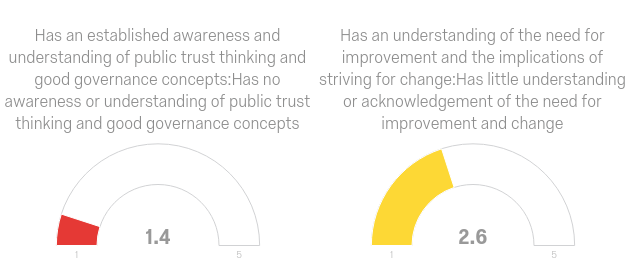
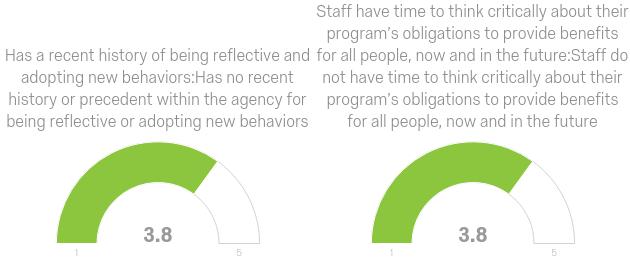 The data is also presented in tabular form, including minimum and maximum values, as well as means. Tabular data can be used to highlight whether evaluators are in agreement or disagreement with respect to their individual assessments.
The data is also presented in tabular form, including minimum and maximum values, as well as means. Tabular data can be used to highlight whether evaluators are in agreement or disagreement with respect to their individual assessments.
Readiness diagnostic questions
We constructed a set of questions team members can use to further analyze their situation, informed by their response to the ACCC instrument. This is best done in a facilitated group session with all team members.
As you engage in the discussion, the team may identify additional questions for consideration. These should be addressed if they add to the diagnosis of agency readiness to proceed with the more inclusive and comprehensive Agency Self-Assessment. Lots of interesting questions about how an agency operates, pressures for change, etc. could be discussed, but focus on readiness should be maintained. In addition to a judgement about readiness to proceed with the more inclusive and comprehensive Agency Self-Assessment, an outcome of the exercise could be identification of potential remedial actions to improve agency characteristics found wanting.
Click for a PDF of the Readiness Diagnostic Questions and some potential actions.
Making a decision to proceed to the next steps
After the team engages in the discussion outlined above, they or perhaps a single leader should be well informed to make a decision either to proceed with the Agency Self-Assessment and workshop, to pause to take remedial actions, or perhaps to proceed with the assessment and take remedial actions. This will be a qualitative judgement, not simply the result of a numerical tally of values from ratings for the ACCC. How the judgment about the next step is arrived at will be largely a reflection of the way the agency makes such decisions, so agency culture will be manifest in the decision-making process, the decision and subsequent actions taken regarding agency readiness.


